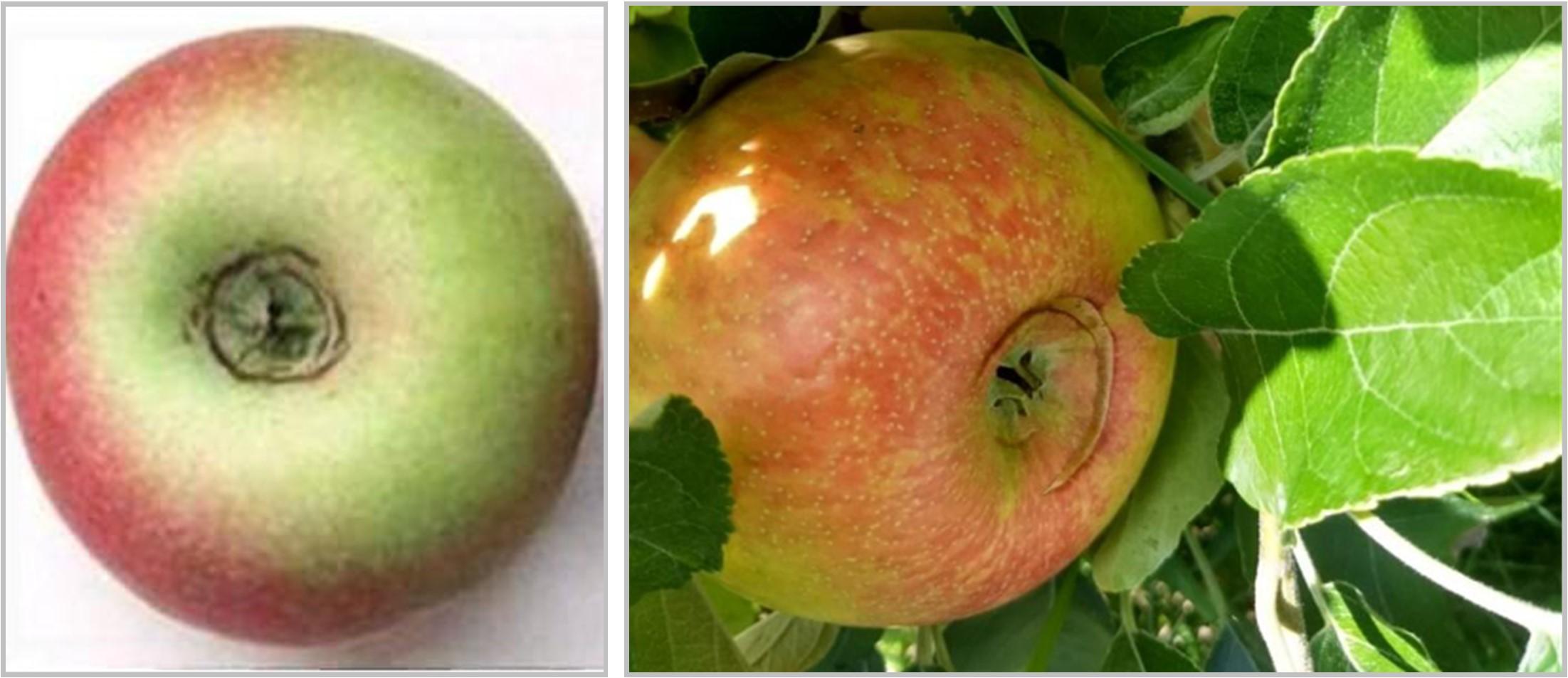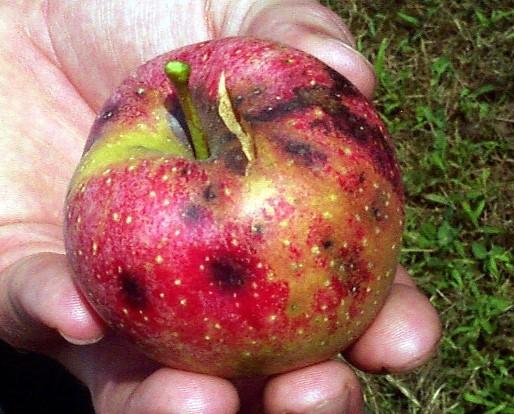Managing Apple Growing Conditions to Prevent Fruit Cracking
What is the apple fruit cracking phenomenon?
Fruit cracking is a phenomenon that strongly limits fruit quality and yields, decreasing fruit marketability and grower profitability. Fruit cracking starts with microcracks in the skin. The skin acts as a protective layer covering the flesh, and consists of a cuticle made of cutin and wax. The microcracks form when the fruit expands more rapidly than when the skin cells and cuticle can form. This typically happens starting around the cell division phase, around 30 days after full bloom, and can continue until harvest. Over the course of the growth period, these cracks can deepen and eventually reach the flesh. These cracks can result in dry fruit flesh, and pathogens can penetrate the flesh and rot the fruit. There are different types of cracking in apples, including stem-end cracking (gash on the side of the apple near the stem, Fig. 1) and calyx-end splitting (ring that is formed around the apple calyx, Fig. 2).

What factors cause or contribute to apple fruit cracking?
There are different factors contributing to the development of fruit cracking, which include genetic susceptibility of the cultivars, environmental factors, pre-harvest practices, as well as post-harvest conditions.
Regarding genetic background, certain cultivars are more prone to cracking than others because genetically they have thinner skin and cuticle layers. Examples of some these cultivars include Gala, Fuji, Golden Delicious and Pink Lady. Furthermore, different apple cultivars can also consistently crack in either the calyx or in the stem-end, or even in both. One example is Gala apples, which are more likely experience stem-end splitting because of different growth rates between skin and flesh cells (Fig. 1). Honeycrisp fruits seem to also be more prone to stem-end splitting (Fig. 2), although they are also susceptible to calyx-end splitting.
Environmental conditions are another important factor defining the susceptibility of apple fruit to cracking. Most fruit cracking occurs because of changes in humidity, especially in cases of rain after a prolonged dry spell, or periods of rain followed by high temperatures During periods of low humidity, the water content in the fruit is lower due to evapotranspiration, a process in which water absorbed by the roots of the tree will evaporate through the leaves. When humidity increases after rain, evapotranspiration is reduced, and the water absorbed from the skin and the water taken up by the roots is stored in the cells of the skin and flesh of the fruit, increasing their size. Both the pressure from enlarged fruit cells as well as growth rate differences between skin and flesh create cracks in the skin. This can be worsened in apple fruits with high sugar concentrations, because water will preferentially stay where there is a higher concentration of soluble molecules. Furthermore, fruits developing in the outer canopy of the tree are also more prone to cracking, as they contain higher sugar concentrations, causing excess water retention. Furthermore, in cultivars such as Cripps Pink, hot and dry environmental conditions during the cell-division stage increases cracking incidence in the fruit, which only becomes visible near harvest time.
Preharvest management strategies, such as pruning, thinning, nutrient management, as well as fruit maturity, are also key in affecting fruit cracking. As evapotranspiration happens through leaves, pruning too late and hard during the season leads to reduced evapotranspiration and therefore increased water retention in the fruit before harvest, resulting in increased fruit cracking. Over-thinning apple trees can be linked to an increased susceptibility to fruit cracking as light crops can have increased fruit size and sugar content due to reduced competition for available nutrients. Nutrient management, as for example calcium and boron contents are also important factors to consider. As calcium is involved in cell division, calcium deficiencies at this stage lead to cracking because of a reduction in skin cell division. Boron is also involved in calcium uptake, so boron deficiencies and calcium deficiencies are often linked. Finally, regarding fruit maturity, fruit cracking will be enhanced in fruits that are harvested later. As with advancing fruit maturity, fruit size and sugar contents increased while flesh firmness and skin strength decreased, leading to a higher cracking susceptibility.
Post-harvest conditions can also contribute to apple fruit cracking. Cracking is more likely to occur when apples are stored in high relative humidity conditions because exposing the surface of the fruit to water or water vapor increases the number, incidence, and severity of microcracks in apples fruits. Although high storage humidity is of key importance in maintaining fruit quality by delaying fruit fresh weight loss and the reduction of flesh firmness, it can also exacerbate the incidence of fruit cracking.
What are the practices that can be implemented to prevent fruit cracking?
Controlling environmental factors to prevent fruit cracking is difficult to achieve, particularly in the Mid-Atlantic, but generally fruit cracking could be alleviated maintaining a constant supply of water during dry and hot stretches of weather. Additionally, avoiding selecting cultivars that have high susceptibility to cracking can be another viable strategy to decrease fruit cracking incidence. Furthermore, preharvest management practices such as late and hard pruning, as well as over-thinning, should be avoided, and a balanced mineral nutrition should be targeted. Avoiding harvesting fruits too late in the season will be another important strategy to decrease fruit cracking susceptibility.
Other practices that can help prevent apple fruit cracking include the use of plant growth regulators and coatings. Plant growth regulators, such as sprays of a mix of gibberellins (GA 4+7) have been shown to increase skin growth rate, and their use is to create a thicker layer of skin cells so that cracks don’t form. Commercial products that contain this gibberellin mix as active ingredient include ProVide (Valent Biosciences). Additionally, plant growth regulators such as ReTain® (AVG, Valent Biosciences), which inhibit ethylene production, have also shown success in decreasing apple fruit cracking. Particularly in Gala, two applications of ReTain®, first at 3-4 weeks before anticipated commercial harvest and a second one 7-10 days before harvest has shown effective in reducing stem-end cracking. Furthermore, the use of coatings, such as ParkaTM (Cultiva LLC), which supplements the fruits’ cuticle reducing microfractures, and thus limiting water movement from the fruit surface into the fruit, has also shown effective in minimizing cracking.
This article appears in April 2023, Volume 14, Issue 2 of the Vegetable and Fruit News.
